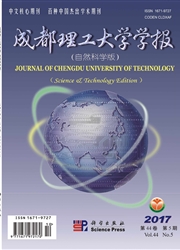

 中文摘要:
中文摘要:
借助钻井岩心与薄片观察、包裹体均一温度测定与地球化学分析等技术手段,结合储层热演化历史恢复成果,对川中磨溪构造寒武系龙王庙组储层特征、孔洞缝充填矿物的次序关系进行分析,并恢复龙王庙组油气运聚期次。研究结果表明,储层岩石类型主要为晶粒残余砂屑白云岩,储集空间以粒间孔、晶间孔为主,但基质的孔隙度和渗透率均较低。储层孔、洞、缝中矿物的充填次序和类型及不同期次包裹体发育特征反映龙王庙组储层至少经历了4期油气成藏,第一期油气成藏发生在中-晚三叠世,被细晶-微晶白云石中均一温度为110-133℃的包裹体所记录;第二期油气充注发生在早-中侏罗世,被孔洞中的第一世代白云石中均一温度为143-167℃的包裹体记录;第三期油气成藏为古油藏在高温作用下裂解为天然气的过程,被储层孔洞缝中充填的第二世代沥青所记录;第四期油气充注发生在中-晚白垩世,被第三世代石英中均一温度为190-210℃的流体包裹体记录。这些不同期次和不同世代的矿物记录了磨溪构造龙王庙组油气成藏流体充注完整的序列和过程。
 英文摘要:
英文摘要:
With the aid of the technology of core research, thin section identification, homogenization temperature measurement and geochemical analysis, and combined with the recovery result of the heat evolutionary history of the Moxi structure reservoir in Central Sichuan, this paper analyzes the filling sequence of the minerals in the rock holes, and recovers the accumulation phases of Cambrian Longwangmiao Formation. The result shows that the main reservoir rock type is residual dolarenite, and the main reservoir spaces are intercrystal and intergranular pores, but the porosity and permeability of the matrix are low. The sequence and types of minerals filling in the holes and cracks, and the development characteristics of the inclusions of different phases reflect that the Longwangmiao Formation reservoir has experienced at least four phases hydrocarbon accumulation. The first time of hydrocarbon filling occurred in the Middle-Late Triassic, and it is recorded by the homogenization temperature (110 - 133℃) of the inclusions in the fine grain-microcrystalline dolomite. The second time hydrocarbon charge occurred in the Early-Middle Jurassic and is recorded by the homogenization temperature (143-167℃) of the inclusions in the first generation of dolomite. The third time of hydrocarbon filling was a process that the ancient reservoir was cracked into gas under high temperature and is recorded by the second generation bituminous minerals filling in the reservoir pore cracks. The fourth time of hydrocarbon filling occurred in the Middle-Late Cretaceous and is recorded by the homogenization temperature (190- 210℃) of the fluid inclusions in the third generation quartz. These different times and different generations of minerals record the complete sequence and processes of the fluid filling in the hydrocarbon accumulation of the Longwangmiao Formation.
 同期刊论文项目
同期刊论文项目
 同项目期刊论文
同项目期刊论文
 期刊信息
期刊信息
